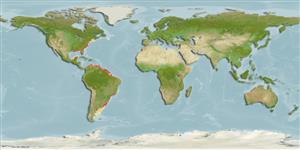>
Eupercaria/misc (Various families in series Eupercaria) >
Sciaenidae (Drums or croakers)
Etymology: Paralonchurus: Greek, para = the side of + Greek, logchos = lance + Greek, oura = tail (Ref. 45335).
More on author: Steindachner.
Environment: milieu / climate zone / depth range / distribution range
Ekologi
laut; payau dasar (demersal); kisaran kedalaman ? - 50 m (Ref. 9626). Tropical
Western Atlantic: Panama to southern Brazil. Reported in Yucatan, Mexico (Ref. 74908).
Length at first maturity / Size / Weight / umur
Maturity: Lm 15.7 range ? - ? cm
Max length : 33.7 cm TL jantan/; (Ref. 125970); common length : 25.0 cm TL jantan/; (Ref. 3702); Berat maksimum terpublikasi: 520.00 g (Ref. 125970)
Duri punggung (Keseluruhan (total)) : 11 - 12; duri punggung lunak (Keseluruhan (total)) : 29 - 30; Duri dubur: 2; Sirip dubur lunak: 8. Body silvery to yellowish, brown above, whitish below. Sides with 7 to 9 dark vertical bars extending to below lateral line. A large dark brown spot, larger than eye, behind upper end of gill slit. Mouth small, inferior, nearly horizontal. Chin with 5 pores and many barbels, 3 or 4 pairs in a tuft around median pore and 10 to 12 pairs along inner edges of lower jaw. Caudal fin asymmetrically rhomboidal with lower half pointed. Gas bladder well developed, much longer than head length, bearing anteriorly 2 pairs of appendages, anterior pair slit and horn-like, lateral pair long, tube-like, and extending posteriorly to tip of main chamber (Ref 51721).
Found over muddy bottoms, often near estuarine areas (Ref. 9626). Feeds mainly on worms (Ref. 3702). Marketed mostly fresh and salted (Ref. 3702).
Life cycle and mating behavior
Kematangan | Reproduksi, perkembang biakan | Pemijahan | telur-telur | Fecundity | Larva
Cervigón, F., 1993. Los peces marinos de Venezuela. Volume 2. Fundación Científica Los Roques, Caracas,Venezuela. 497 p. (Ref. 9626)
Status IUCN Red List (Ref. 130435: Version 2024-2)
ancaman kepada manusia
Harmless
penggunaan manusia
Perikanan: nilai komersial kecil
Alat, peralatan
laporan khas
muat turun XML
Sumber internet
Estimates based on models
Preferred temperature (Ref.
123201): 14 - 27.8, mean 24 °C (based on 564 cells).
Phylogenetic diversity index (Ref.
82804): PD
50 = 0.5156 [Uniqueness, from 0.5 = low to 2.0 = high].
Bayesian length-weight: a=0.00759 (0.00705 - 0.00816), b=3.08 (3.06 - 3.10), in cm total length, based on LWR estimates for this species (Ref.
93245).
Trophic level (Ref.
69278): 3.4 ±0.3 se; based on diet studies.
Daya lenting (Ref.
120179): Tinggi, Waktu penggandaan populasi minimum kurang dari 15 bulan (Preliminary K or Fecundity.).
Fishing Vulnerability (Ref.
59153): Low vulnerability (24 of 100).
Nutrients (Ref.
124155): Calcium = 184 [108, 359] mg/100g; Iron = 1.18 [0.63, 2.04] mg/100g; Protein = 19 [18, 20] %; Omega3 = 0.243 [0.129, 0.403] g/100g; Selenium = 48.1 [26.7, 89.8] μg/100g; VitaminA = 20 [8, 53] μg/100g; Zinc = 1.49 [1.09, 2.12] mg/100g (wet weight);
